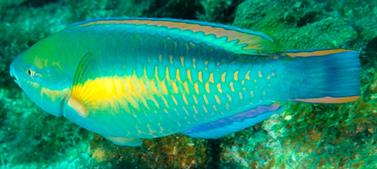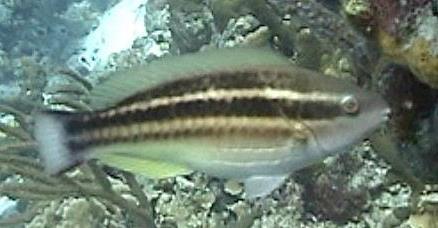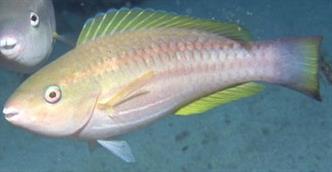




Scarus taeniopterus
| Ecological Descriptors |
||||
| Habitat | Size (cm) | Diet | Behaviour | Sex |
| Co, S | 35 | Veg | I | PGH |
General:
Parrotfish owe their name to the shape of their mouth. Instead of teeth they have two beak-like plates, like parrots. They have even rows of large, noticeable scales on their bodies. The development of parrotfishes is complex and accompanied by a series of changes in color (polychromatism). Individuals usually mature as females (Initial Phase), with some later changing to the male sex (Terminal Phase). Large robust scales are prominent.
Description:
Terminal phase: Body blue to green, with two blue to green stripes extending from the snout and passing across the eye. Borders of the tail yellow to orange or pink. Midbody with a yellow or orangish stripe, fading toward the rear. A distinct yellow or orange or pink stripe runs along the base of the dorsal fin
Initial phase: Body brownish with dark stripes. With maturity, the stripes fade and become brown. Fins often become yellowish. Borders of tail dark.
Juvenile phase: Body with three black stripes, two white stripes and a white belly, often with thin silver stripes. Never has a yellow snout, upper/ lower borders of tail dark. (Cf Striped Parrotfish)
Ecology
This species is reef and seagrass associated from 1-25m. It is found in shallow clear reefs and seagrass (Thalassia) beds. It forms schools and feeds on algae. Juveniles are found on seagrass beds. Forms large feeding aggregations and feeds on plants. Sleeps in a mucus cocoon
Life Cycle:
It is a protogynous hermaphrodite. Distinct pairing during breeding. Diandric meaning they can be born either male or female. Two types of males, primary and secondary. Primary males are those males born male, however secondary males are females that have become male by undergoing a change in sex. Individual parrotfishes go through three separate stages, which differ by colour and sexual maturity. The first phase, consists of juveniles, dull in colour and have not reached sexual maturity. The initial phase (IP) is the second phase, includes females and males that cannot be differentiated without examining internals. Terminal phase (TP) consists of mature males; displaying bright colours. TP males typically dominate reproduction. When a TP male dies this normally signals an IP female to undergo changes in behaviour and sex. The IP males display what is known as ‘sneak spawning / Streaking’ by infiltrating the harem of a TP male by pretending to be a female. The IP male follows the spawning pair while releasing a mist of sperm into the water column during the peak time for mating thus attempting to overwhelm fertilization by the TP male, as IP males are able to produce more sperm.
Remarks:
Initial and juvenile phases of the Princess parrotfish often mix with similar age Striped parrotfish (Scarus iserti). Striped parrotfish can be distinguished by the lack of dark borders on the tail.
Parrotfish owe their name to the shape of their mouth. Instead of teeth they have two beak-like plates, like parrots. They have even rows of large, noticeable scales on their bodies. The development of parrotfishes is complex and accompanied by a series of changes in color (polychromatism). Individuals usually mature as females (Initial Phase), with some later changing to the male sex (Terminal Phase). Large robust scales are prominent.
Description:
Terminal phase: Body blue to green, with two blue to green stripes extending from the snout and passing across the eye. Borders of the tail yellow to orange or pink. Midbody with a yellow or orangish stripe, fading toward the rear. A distinct yellow or orange or pink stripe runs along the base of the dorsal fin
Initial phase: Body brownish with dark stripes. With maturity, the stripes fade and become brown. Fins often become yellowish. Borders of tail dark.
Juvenile phase: Body with three black stripes, two white stripes and a white belly, often with thin silver stripes. Never has a yellow snout, upper/ lower borders of tail dark. (Cf Striped Parrotfish)
Ecology
This species is reef and seagrass associated from 1-25m. It is found in shallow clear reefs and seagrass (Thalassia) beds. It forms schools and feeds on algae. Juveniles are found on seagrass beds. Forms large feeding aggregations and feeds on plants. Sleeps in a mucus cocoon
Life Cycle:
It is a protogynous hermaphrodite. Distinct pairing during breeding. Diandric meaning they can be born either male or female. Two types of males, primary and secondary. Primary males are those males born male, however secondary males are females that have become male by undergoing a change in sex. Individual parrotfishes go through three separate stages, which differ by colour and sexual maturity. The first phase, consists of juveniles, dull in colour and have not reached sexual maturity. The initial phase (IP) is the second phase, includes females and males that cannot be differentiated without examining internals. Terminal phase (TP) consists of mature males; displaying bright colours. TP males typically dominate reproduction. When a TP male dies this normally signals an IP female to undergo changes in behaviour and sex. The IP males display what is known as ‘sneak spawning / Streaking’ by infiltrating the harem of a TP male by pretending to be a female. The IP male follows the spawning pair while releasing a mist of sperm into the water column during the peak time for mating thus attempting to overwhelm fertilization by the TP male, as IP males are able to produce more sperm.
Remarks:
Initial and juvenile phases of the Princess parrotfish often mix with similar age Striped parrotfish (Scarus iserti). Striped parrotfish can be distinguished by the lack of dark borders on the tail.
Princess Parrotfish TP
Princess Parrotfish Juvenile


Princess Parrotfish IP




Princess Parrotfish Juvenile






Princess Parrotfish TP
598

